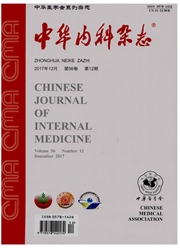

 中文摘要:
中文摘要:
目的应用磁共振弥散张量成像技术以及自动化影像分析工具研究遗忘型轻度认知功能障碍(aMCI)大脑白质结构的变化。方法对受试者进行临床和神经心理评估,31例受试者(aMCI组15例,对照组16例)接受磁共振弥散张量成像技术扫描。所有影像资料经与标准模板配准后,采用基于像素的图像分析法确定两组各向异性分数有差异的脑区。结果aMCI组简易智力状态检查量表(MMSE)(26.93±1.49)分,蒙特利尔认知评估量表(MoCA)(22.73±1.91)分,对照组MMSE(29.44±0.81)分,MOCA(26.50±1.17)分,差异有统计学意义(P〈0.05)。在aMCI组双侧额叶部分自质区域异性分数值低于对照组(P〈0.001)。结论额叶白质损伤可能参与了aMCI的病理生理过程的变化。
 英文摘要:
英文摘要:
Objectives To measure the microstructural differences in the brains of participants with amnestic mild cognitive impairment (aMCI) and compare with a control group using a magnetic resonance diffusion tensor imaging (DTI) technique with fully automated image analysis tools. Methods A standardized clinical and neuropsychological evaluation was conducted on each subject. 31 participants (15 participants with aMC1, 16 healthy elderly adults ) underwent magnetic resonance imaging (MRI)-based DTI. To control the effects of anatomical variation, the diffusion images of all participants were registered to standard anatomical space. Voxel-by-voxel comparisons showed significant regional reductions in white matter regions of fractional anisotropy (FA) in the participants with aMCI as compared with the controls. Results Significantly decreased FA value measurements (P 〈 0. 001 ) were observed in the right frontal white matter in participants with aMCI. Moreover, there was a statistically significant difference between the patients with aMCI and controls in considering the small regions of bilateral superior frontal gyrus white matter (P 〈 0. 001 ). Conclusions White matter damage of frontal lobe may play an important role in histopathologic changes associated with amnestic mild cognitive impairment.
 同期刊论文项目
同期刊论文项目
 同项目期刊论文
同项目期刊论文
 Identification of conversion from mild cognitive impairment to Alzheimer's disease using multivariat
Identification of conversion from mild cognitive impairment to Alzheimer's disease using multivariat Functional Connectivity of New Supplement of Limbic System, Marginal Division, Affected in Alzheimer
Functional Connectivity of New Supplement of Limbic System, Marginal Division, Affected in Alzheimer Age of onset of blindness affects brain anatomical networks constructed using diffusion tensor tract
Age of onset of blindness affects brain anatomical networks constructed using diffusion tensor tract Altered spontaneous activity in Alzheimer's disease and mild cognitive impairment revealed by Region
Altered spontaneous activity in Alzheimer's disease and mild cognitive impairment revealed by Region Impaired Long Distance Functional Connectivity and Weighted Network Architecture in Alzheimer's Dise
Impaired Long Distance Functional Connectivity and Weighted Network Architecture in Alzheimer's Dise 期刊信息
期刊信息
